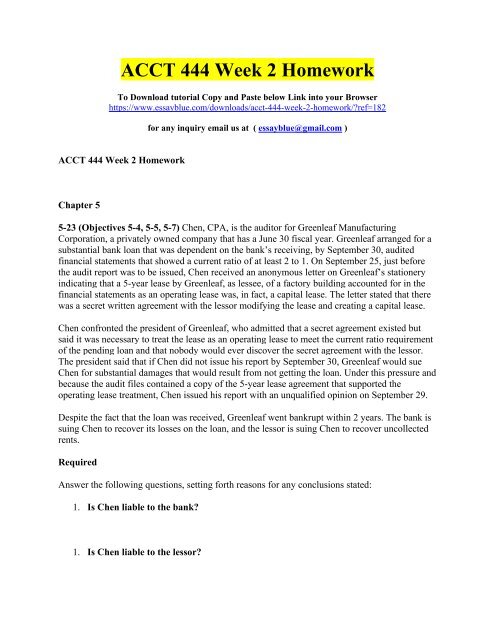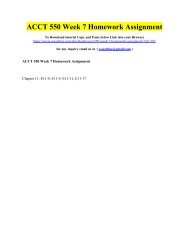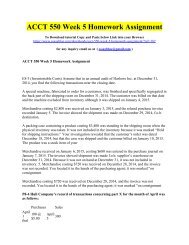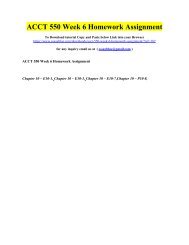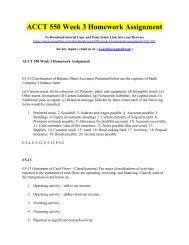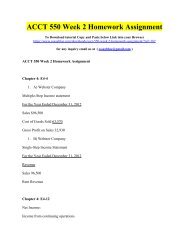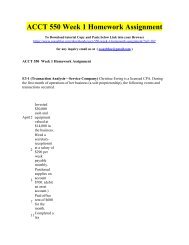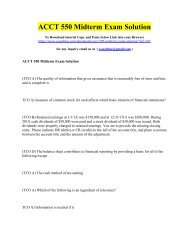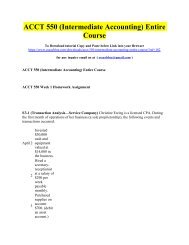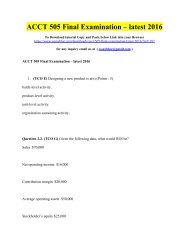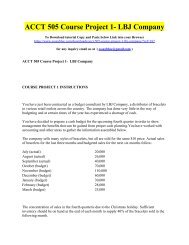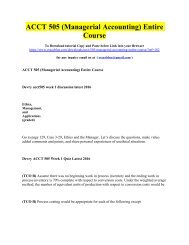ACCT 444 Week 2 Homework
ACCT 444 Week 2 Homework
ACCT 444 Week 2 Homework
Create successful ePaper yourself
Turn your PDF publications into a flip-book with our unique Google optimized e-Paper software.
<strong>ACCT</strong> <strong>444</strong> <strong>Week</strong> 2 <strong>Homework</strong><br />
To Download tutorial Copy and Paste below Link into your Browser<br />
https://www.essayblue.com/downloads/acct-<strong>444</strong>-week-2-homework/?ref=182<br />
for any inquiry email us at ( essayblue@gmail.com )<br />
<strong>ACCT</strong> <strong>444</strong> <strong>Week</strong> 2 <strong>Homework</strong><br />
Chapter 5<br />
5-23 (Objectives 5-4, 5-5, 5-7) Chen, CPA, is the auditor for Greenleaf Manufacturing<br />
Corporation, a privately owned company that has a June 30 fiscal year. Greenleaf arranged for a<br />
substantial bank loan that was dependent on the bank’s receiving, by September 30, audited<br />
financial statements that showed a current ratio of at least 2 to 1. On September 25, just before<br />
the audit report was to be issued, Chen received an anonymous letter on Greenleaf’s stationery<br />
indicating that a 5-year lease by Greenleaf, as lessee, of a factory building accounted for in the<br />
financial statements as an operating lease was, in fact, a capital lease. The letter stated that there<br />
was a secret written agreement with the lessor modifying the lease and creating a capital lease.<br />
Chen confronted the president of Greenleaf, who admitted that a secret agreement existed but<br />
said it was necessary to treat the lease as an operating lease to meet the current ratio requirement<br />
of the pending loan and that nobody would ever discover the secret agreement with the lessor.<br />
The president said that if Chen did not issue his report by September 30, Greenleaf would sue<br />
Chen for substantial damages that would result from not getting the loan. Under this pressure and<br />
because the audit files contained a copy of the 5-year lease agreement that supported the<br />
operating lease treatment, Chen issued his report with an unqualified opinion on September 29.<br />
Despite the fact that the loan was received, Greenleaf went bankrupt within 2 years. The bank is<br />
suing Chen to recover its losses on the loan, and the lessor is suing Chen to recover uncollected<br />
rents.<br />
Required<br />
Answer the following questions, setting forth reasons for any conclusions stated:<br />
1. Is Chen liable to the bank?<br />
1. Is Chen liable to the lessor?
1. Is there potential for criminal action against Chen?<br />
5-24 (Objective 5-6) Under Section 11 of the Securities Act of 1933 and Section 10(b), Rule<br />
10b-5, of the Securities Exchange Act of 1934, a CPA may be sued by a purchaser of registered<br />
securities. The following items relate to what a plaintiff who purchased securities must prove in a<br />
civil liability suit against a CPA.<br />
The plaintiff security purchaser must allege or prove:<br />
1. Material misstatements were included in a filed document.<br />
2. A monetary loss occurred.<br />
3. Lack of due diligence by the CPA.<br />
4. Privity with the CPA.<br />
5. Reliance on the financial statements.<br />
6. The CPA had scienter (knowledge and intent to deceive).<br />
Required<br />
For each of the items 1 through 6 listed above, indicate whether the statement must be proven<br />
under<br />
1. Section 11 of the Securities Act of 1933 only.<br />
1. Section 10(b) of the Securities Exchange Act of 1934 only.<br />
1934. Both Section 11 of the Securities Act of 1933 and Section 10(b) of the<br />
Securities Exchange Act of 1934.
1934. Neither Section 11 of the Securities Act of 1933 nor Section 10(b) of the<br />
Securities Exchange Act of 1934.*<br />
Chapter 6<br />
6-23 (Objectives 6-1, 6-3) Auditors provide “reasonable assurance” that the financial statements<br />
are “fairly stated, in all material respects.” Questions are often raised as to the responsibility of<br />
the auditor to detect material misstatements, including misappropriation of assets and fraudulent<br />
financial reporting.<br />
Required<br />
1. Discuss the concept of “reasonable assurance” and the degree of confidence that<br />
financial statement users should have in the financial statements.<br />
.<br />
1. What are the responsibilities of the independent auditor in the audit of financial<br />
statements? Discuss fully, but in this part do not include fraud in the discussion.<br />
.<br />
1. What are the responsibilities of the independent auditor for the detection of fraud<br />
involving misappropriation of assets and fraudulent financial reporting? Discuss<br />
fully, including your assessment of whether the auditor’s responsibility for the<br />
detection of fraud is appropriate.<br />
6-27 (Objectives 6-6, 6-7) The following are specific transaction-related audit objectives applied<br />
to the audit of cash disbursement transactions (a through f), management assertions about classes<br />
of transactions (1 through 5), and general transaction-related audit objectives (6 through 11).
Specific Transaction-Related Audit Objective<br />
1. Recorded cash disbursement transactions are for the amount of goods or services received<br />
and are correctly recorded.<br />
2. Cash disbursement transactions are properly included in the accounts payable master file<br />
and are correctly summarized.<br />
3. Recorded cash disbursements are for goods and services actually received.<br />
4. Cash disbursement transactions are properly classified.<br />
5. Existing cash disbursement transactions are recorded.<br />
6. Cash disbursement transactions are recorded on the correct dates.<br />
Required<br />
1. Explain the differences among management assertions about classes of transactions<br />
and events, general transaction-related audit objectives, and specific transactionrelated<br />
audit objectives and their relationships to each other.<br />
1. For each specific transaction-related audit objective, identify the appropriate<br />
management assertion.<br />
2. For each specific transaction-related audit objective, identify the appropriate<br />
general transaction-related audit objective.<br />
Chapter 11<br />
11-30 (Objective 11-1) The following are activities that occurred at Franklin Manufacturing, a<br />
nonpublic company.<br />
1. Franklin’s accountant did not record checks written in the last few days of the year until<br />
the next accounting period to avoid a negative cash balance in the financial statements.<br />
2. Franklin’s controller prepared and mailed a check to a vendor for a carload of material<br />
that was not received. The vendor’s chief accountant, who is a friend of Franklin’s<br />
controller, mailed a vendor’s invoice to Franklin, and the controller prepared a receiving<br />
report. The vendor’s chief accountant deposited the check in an account he had set up<br />
with a name almost identical to the vendor’s.
3. The accountant recorded cash received in the first few days of the next accounting period<br />
in the current accounting period to avoid a negative cash balance.<br />
4. Discounts on checks to Franklin’s largest vendor are never taken, even though the bills<br />
are paid before the discount period expires. The president of the vendor’s company<br />
provides free use of his ski lodge to the accountant who processes the checks in exchange<br />
for the lost discounts.<br />
5. Franklin shipped and billed goods to a customer in New York on December 23, and the<br />
sale was recorded on December 24, with the understanding that the goods will be<br />
returned on January 31 for a full refund plus a 5 percent handling fee.<br />
6. Franklin’s factory superintendent routinely takes scrap metal home in his pickup and sells<br />
it to a scrap dealer to make a few extra dollars.<br />
7. Franklin’s management decided not to include a footnote about a material uninsured<br />
lawsuit against the company on the grounds that the primary user of the statements, a<br />
small local bank, will probably not understand the footnote anyway.<br />
Required<br />
1. Identify which of these activities are frauds.<br />
1. For each fraud, state whether it is a misappropriation of assets or fraudulent<br />
financial reporting.


